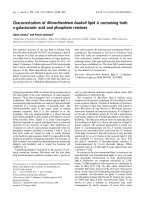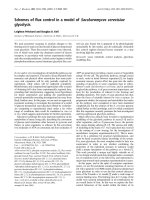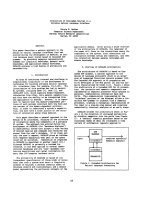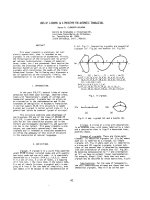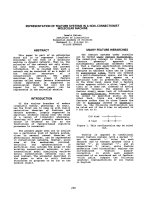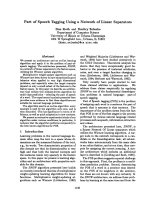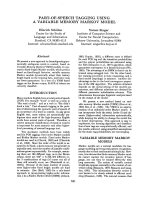báo cáo khoa học: "Osteoarthritis of the talonavicular joint with pseudarthrosis of the navicular bone: a case report " pps
Bạn đang xem bản rút gọn của tài liệu. Xem và tải ngay bản đầy đủ của tài liệu tại đây (522.19 KB, 14 trang )
This Provisional PDF corresponds to the article as it appeared upon acceptance. Fully formatted
PDF and full text (HTML) versions will be made available soon.
Osteoarthritis of the talonavicular joint with pseudarthrosis of the navicular
bone: a case report
Journal of Medical Case Reports 2011, 5:547 doi:10.1186/1752-1947-5-547
Noriyuki Kanzaki ()
Takayuki Nishiyama ()
Takaaki Fujishiro ()
Shinya Hayashi ()
Yoshiyuki Takakura ()
Yoshinori Takakura ()
Masahiro Kurosaka ()
ISSN 1752-1947
Article type Case report
Submission date 8 August 2011
Acceptance date 8 November 2011
Publication date 8 November 2011
Article URL />This peer-reviewed article was published immediately upon acceptance. It can be downloaded,
printed and distributed freely for any purposes (see copyright notice below).
Articles in Journal of Medical Case Reports are listed in PubMed and archived at PubMed Central.
For information about publishing your research in Journal of Medical Case Reports or any BioMed
Central journal, go to
/>For information about other BioMed Central publications go to
/>Journal of Medical Case
Reports
© 2011 Kanzaki et al. ; licensee BioMed Central Ltd.
This is an open access article distributed under the terms of the Creative Commons Attribution License ( />which permits unrestricted use, distribution, and reproduction in any medium, provided the original work is properly cited.
Osteoarthritis of the talonavicular joint with pseudarthrosis of the navicular bone: a case
report
Noriyuki Kanzaki
1
*, Takayuki Nishiyama
1
, Takaaki Fujishiro
1
, Shinya Hayashi
1
, Yoshiyuki
Takakura
2
, Yoshinori Takakura
2
, Masahiro Kurosaka
1
1
Department of Orthopedic Surgery, Kobe University Graduate School of Medicine, 7-5-1,
Kusunoki-Cho, Tyuo-Ku, Kobe, 650-0017, Japan;
2
Department of Orthopedic Surgery,
Takakura Orthopedic and Sports Clinic, 5-4-21, Tokui-Cho, Nada-Ku, Kobe, 657-0033, Japan
*Corresponding author
NK:
TN:
TF:
SH:
YYT:
YNT:
MK:
Abstract
Introduction: Osteoarthritis of the talonavicular joint caused by inflammatory, degenerative,
and post-traumatic arthritis has been commonly described, and isolated arthrodesis for
talonavicular joint has usually been performed for such conditions. However, arthritis
accompanied by pseudarthrosis of the navicular bone is an extremely rare case, and to the
best of our knowledge, isolated arthrodesis for this situation has not been previously
described in any published reports.
Case presentation: The patient was a 39-year-old Japanese man. He had complained of pain
in his left middle foot since a fall from his motorcycle six months previously. Radiographs
and computed tomography (CT) scans revealed pseudarthrosis of the navicular bone. MRI
indicated mild arthritic change in the talonavicular joint and avascular necrosis of the
navicular bone. We performed an isolated arthrodesis of the talonavicular joint with two
6.5mm cancellous screws. One year after the operation, radiographical bone union had been
obtained, and the patient reported no pain and complete satisfaction with the result.
Conclusions: Isolated talonavicular arthrodesis is one of the effective procedures for the
treatment of traumatic talonavicular arthritis with pseudarthrosis of the navicular bone both
in providing pain relief and functional improvement.
Introduction
Osteoarthritis of the talonavicular joint caused by inflammatory arthritis such as rheumatoid
arthritis and pes valgus deformity has been commonly described [1, 2], but osteoarthritis
occurring as a result of fracture of the navicular bone is rare [3]. Arthritis accompanied by
pseudarthrosis of the navicular bone is an extremely rare case.
Isolated arthrodesis for talonavicular joint has usually been performed for pes valgus
deformities, congenital deformities, neuromuscular diseases, and arthritic conditions,
including inflammatory, degenerative, or post-traumatic arthritis [3-11].
We report a case of osteoarthritis of the talonavicular joint accompanied by pseudarthrosis
of the navicular bone, which was treated with isolated arthrodesis for the talonavicular joint.
Case presentation
A 39-year-old Japanese man sustained an injury to his left foot. He had fallen from his
motorcycle and was unable to remember the precise mechanism of injury. He visited his
local hospital where he was diagnosed with a navicular fracture and treated with a short-leg
cast for six weeks. He was referred to our institution because of nonresolution of his
prolonged foot pain six months after the initial injury.
Physical examination revealed that his left foot was slightly swollen, but the skin color was
normal and there was no local heat on his instep. Blood tests did not indicate infection or
inflammatory disease. There was tenderness over his middle foot, and he had active toe
plantar flexion and dorsal flexion without restriction. Injections of lidocaine on the navicular
bone resulted in temporary resolution of pain. Radiographs and CT scans revealed that
navicular bone union had not been obtained and the fragments were atrophic. There was
also associated incongruity of the cuneonavicular joint (Figure 1 and 2). T1-weighted MRI
showed low-signal intensity on the lateral fragment, and T2-weighted MRI revealed high-
signal intensity on the talonavicular joint and a slightly ragged joint cartilage, and a
homogenous high-signal intense cystic lesion in the talus (Figure 3). We suspected there was
avascular necrosis of the navicular bone fragment, and primitive osteoarthritis of the
talonavicular joint because of the preserved joint space.
The surgical technique used two longitudinal incisions on the lateral and medial fragment of
the navicular bone. The gap of pseudarthrosis was filled with soft tissue and there was no
movement between the two fragments. The talonavicular joint capsule was opened widely
to expose the articular surfaces of the talar head and proximal navicular. The articular
cartilage was damaged and partially eburnated. After opening the joint capsule we removed
the remainder of the cartilage from the articular surface of the talar head and navicular bone
by roughening the subchondral bone using a shaver and chisel. Compression and fixation of
the talonavicular joint were achieved using two 6.5mm partially threaded cancellous screws
(SYNTHES), which were both inserted in a distal- to- proximal orientation (Figure 4).
Postoperatively, a short leg cast was applied for six weeks. Progressive weight-bearing as
tolerated was allowed after removing the cast.
The patient was followed clinically and radiographically at regular intervals, and one year
after the operation, joint fusion was radiographically obtained, and he reported no pain or
disability (Figure 5).
Discussion
There are few cases in the literature describing the result of isolated talonavicular
arthrodesis in patients with traumatic arthritis [3, 6]. Most of the literature addresses
patients with either inflammatory arthritis or adult acquired flat foot [4, 5, 7-11]. Main
reported that the fracture of navicular was caused by shearing forces between the
cuneiforms and the talar head, and triple arthrodesis was effective for persistent symptoms
[12] while Chen maintained that isolated talonavicular arthrodesis provided both pain relief
and functional improvement in traumatic arthritis [3].
In our case, images revealed aspects of osteoarthritis of the talonavicular joint and
pseudarthrosis of the navicular bone, and we suspected lidocaine penetrated to the
talonavicular joint and the gap of pseudarthrosis. Therefore, we thought the middle foot
pain was caused by both osteoarthritis and pseudarthrosis and we planned to perform both
a fixation of the navicular bone fragments and arthrodesis of the talonavicular joint. In fact,
the gap of navicular pseudarthrosis was filled with soft fibrous tissues. However, no
abnormal mobility between navicular bone fragments was identified. In the talonavicular
joint, the articular surface was partially eburnated, and osteophyte and bone cyst were
found. We concluded that the middle foot pain was derived from osteoarthritis of the
talonavicular joint, and performed isolated arthrodesis for the talonavicular joint. However,
if abnormal mobility had existed between the two fragments of the navicular bone, we
would have performed not only arthrodesis of the talonavicular joint but also fixation of the
navicular bone fragments or additional bone transplantation. As a result, three months after
the operation, the patient felt no middle foot pain and was able to return to work as a bus
driver. One year after the operation, radiography showed that the talonavicular joint was
fully fused.
Conclusion
Isolated talonavicular arthrodesis is one of the effective procedures for the
treatment of traumatic talonavicular arthritis due to an ununited navicular bone
without abnormal movement both in providing pain relief and functional
improvement.
Consent
Written informed consent was obtained from the patient for publication of this case report
and any accompanying images. A copy of the written consent is available for review by the
Editor-in-Chief of the journal.
Competing interests
The authors declare that they have no competing interests.
Authors' contributions
NK performed the surgical procedure, examined the case file, reviewed the literature and
made major contributions to the writing of the manuscript. TN, YYT, and YNT participated in
surgery and contributed in the conception and design of the manuscript. TF, SH and MK also
contributed to writing the manuscript and its preparation. All authors read and approved the
final manuscript.
References
1. Mann RA: Flatfoot in adult. In Surgery of the foot and ankle. 6th edition. Edited by Mann
RA, Coughlin MJ. St. Louis: Mosby; 1992: 757-784.
2. Thompson FM, Mann RA: Degenerative arthritis of the talonavicular joint. In Surgery of
the foot and ankle. 6th edition. Edited by Mann RA, Coughlin MJ. St. Louis: Mosby; 1992:
636-637.
3. Chen CH, Huang PJ, Chen TB, Cheng YM, Lin SY, Chiang HC, Chen LC: Isolated
talonavicular arthrodesis for talonavicular arthritis. Foot Ankle Int 2001, 325:633-636.
4. Chiodo CP, Martin T, Wilson MG: A technique for isolated arthrodesis for inflammatory
arthritis of the talonavicular joint. Foot Ankle Int 2000, 21:307-310.
5. Harper MC, Tisdel CL: Talonavicular arthrodesis for the painful adult acquired flatfoot.
Foot Ankle Int 1996, 17:658-661.
6. Johnstone AJ, Maffulli N: Primary fusion of the talonavicular joint after fracture
dislocation of the navicular bone. J Trauma 1998, 45:1100-1102.
7. Kindsfater K, Wilson MG, Thomas WH: Management of the rheumatoid hindfoot with
special reference to talonavicular arthrodesis. Clin Orthop 1997, 340:69-74.
8. O`Malley MJ, Deland JT, Lee KT: Selective hindfoot arthrodesis for the treatment of
adult acquired flatfoot deformity: an in vitro study. Foot Ankle Int 1995, 16:411-417.
9. Swaroop VT, Wenger DR, Mubarak SJ: Talonavicular fusion for dorsal subluxation of the
navicular in resistant clubfoot. Clin Orthop Relat Res 2009, 467:1314-1318.
10. Popelka S, Hromádka R, Vavrík P, Stursa P, Pokorný D, Jahoda D, Sosna A: Isolated
talonavicular arthrodesis in patients with rheumatoid arthritis of the foot and tibialis
posterior tendon dysfunction. BMC Musculoskelet Disord 2010, 11:38.
11. Camasta CA, Menke CR, Hall PB: A review of 51 talonavicular joint arthrodeses for
flexible pes valgus deformity. J Foot Ankle Surg 2010, 49:113-118.
12. Main BJ, Jowett RL: Injuries of the midtarsal joint. J Bone Joint Surg Br 1975, 57:89-97.
Figure legends
Figure 1: Radiographs at the time of presentation showed atrophic bones and non-union of
navicular fragments. (A) Lateral radiograph. (B) Oblique radiograph.
Figure 2: Computed tomography scans at the time of presentation. (A) Axial image. (B)
Coronal image.
Figure 3: Preoperative magnetic resonance images. (A) Axial T1-weighted image showed
avascular necrosis of the navicular bone and existence of a cystic lesion in the talar head.
(B) Sagittal T2-weighted image showed slightly ragged talonavicular joint cartilage and
incongruity of the talonavicular and navicular-cuneiforms joints.
Figure 4: Postoperative radiographs showed fixation with two screws. (A) Anteroposterior
radiograph. (B) Lateral radiograph.
Figure 5: Lateral radiograph at one year after the operation showed completely united
talonavicular joint.
Figure 1
Figure 2
Figure 3
Figure 4
Figure 5
